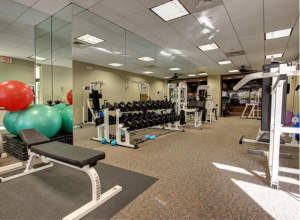This morning Dad had his third bone marrow biopsy and received two bags of platelets in anticipation of the procedure to place his central line catheter tomorrow, Friday, February 19th.
At 1:00 p.m., we met with two different nurses, not Denise, and Dr. Ayala. First, we learned that the 19 year old donor passed the physical examination. Excellent.
 Next, Dr. Ayala examined Dad and confirmed that Dad is ready for the transplant and that his disease
Next, Dr. Ayala examined Dad and confirmed that Dad is ready for the transplant and that his disease
is minimized as much as possible. Dr. Ayala reminded us that every transplant is different and that there will be bumps along the way. He stressed the importance for Dad to stay very active physically and mentally. Dad bragged to the doctor that he was in the gym earlier in the week for 45 minutes with 20 minutes on the stationary bike.
Dr. Ayala reviewed the risks of the transplant again. CTCL patients are at a high risk of skin infection since CTCL is a skin related cancer. He also discussed graft versus host (GvH), and he reminded us that Dad’s chance of death is 25-30%, which is higher than the traditional CTCL patient due to Dad’s age. At 75.9 years old, Dad will be the oldest patient to ever receive a stem cell transplant at the Moffitt Cancer Center. Wow! Doctors seem to believe that Dad’s body is closer to that of a healthy 55 year old. The medical staff continue to be amazed with Dad’s positive demeanor and “can do” attitude. They also recognize the outstanding support Mom provides non-stop daily. I know that these are key drivers in Dad being a candidate for a stem cell transplant. Dad is raising the “age” bar.
As we discussed the risk of death, Dr. Ayala said he would be honest and forthright about Dad’s condition. Dr. Ayala shared his view about not using life support. Dad reviewed his advance directive, now using Five Wishes, with Dr. Ayala. Dad made it clear as to when he would want to be resuscitated and when he would not. I inquired about ensuring that Dr. Ayala would indicate the best time to transition to hospice.
Days are named and tracked based upon the actual day Dad is to be infused with the donor’s stem cells. The days leading up to that day are noted as “negative” while the days after are noted as “positive.”
The plan for Sunday, February 21 (aka DAY -5), is for Dad to call at 10:00 a.m. to see if a bed is available. If so, we go to Moffitt and check Dad in as an inpatient. If no bed is available yet, Dad will go to the Blood and Marrow Transplant clinic, also at the Moffitt Cancer Center, for blood work and prep for his first of four days of chemotherapy, fludarabine, to begin Sunday evening. The assumption is that a bed will eventually be available that same day.
Last, we spent a fair amount of time with two pharmacists, Bryan, a pharmacist resident, and Amy. All of Dad’s current and future medications were reviewed in great detail. We discussed the two chemotherapy drugs, fludarabine and melphalan, to be given during the first four days of Dad being an inpatient. Melphalan is a drug, which may cause Dad mucositis. Last year, Dad experienced severe mucositis of the mouth as a terribly painful side effect of FOLOTYN, another chemotherapy drug. He was living on milkshakes and Boost for one to two weeks.
The pharmacists said that Dad will be infused with the donor’s stem cells as soon as they arrive…even in the middle of the night, which is the famous DAY 0.
We also discussed what will be done to prevent GvH. The donor’s cells could attack Dad’s skin, GI tract and liver. The first method of prevention is through intravenous cyclophosphamide on DAY +4 & DAY +5. This drug can delay the time for the cells to engraft. Cyclophosphamide does not harm the donor’s stem cells. It spares the good T-cells (regulatory T-cells) and knocks out the harmful T-cells. The second method of GvH prevention is sirolimus, starting on DAY +5.
Also starting on DAY +5 is a daily neupogen shot to accelerate the recovery of the new stem cells. The daily shots of neupogen will be given until Dad achieves a neutrophil count of 1,500/mm3 of blood.

Recent Comments